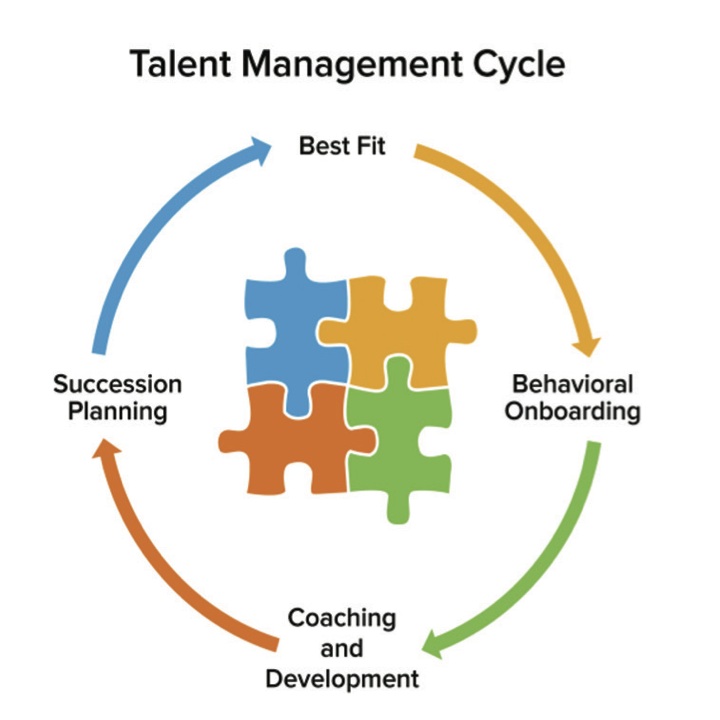
By Jason Taylor
Every employee within an organization has a career arc that is referred to as the employee life cycle. Some employees have a very short life cycle, while other employees find opportunities that fulfill their career objectives for the long term. There are both benefits and challenges to lengthening the employee lifecycle. Organizations that have employees with improved job satisfaction often experience increased retention and reduced turnover. But to achieve this, companies needs to deliver their workforce with growth opportunities, personal development, and upward mobility.
Behavioral science provides a method to bridge the gap between the employee’s and the organization’s needs. A short definition of behavioral science is the compilation of on-the-job core behaviors for a specific position which are then used to recruit, select, onboard, and develop hires in those target positions.
Through behavioral science, job seekers are able to capitalize on career development and increased job satisfaction by scientifically being matched to the right job and being developed to their full potential. When behavioral science is aligned with the employee life cycle, it supports an employee experience to maximize satisfaction and growth.
Best Fit
The seeds of success are planted at the beginning of the employee life cycle. Fit to the job is the first key to the puzzle. Some organizations focus only on “fit” in terms of skills or résumé keywords, but those facts only tell a small part of the story. They do not provide deep insight into longevity, culture fit, or productivity potential. The secret ingredient is behavioral fit, which captures the things managers can’t see on paper—behaviors! But through technology, organizations are able to compare an individual’s behavioral preferences to a behavioral benchmark. The individual’s behavioral preferences are based on actual performance data, and the behavioral benchmark is based on skills statistically proven to represent success on the job. Statistically, the closer the match to the behavioral pattern, the higher probability a person has to achieving success based on actual performance related to the job.
This process can be scaled to the employer’s needs and ensure that all levels of positions are filled with top-quality hires, while maximizing the employee’s contribution and satisfaction in the organization.
Finding the best fit can pay off in financial savings and earnings. For example, a well-known national restaurant chain deployed a behavioral science solution to select
new employees for server positions using a behavioral benchmark built on successful incumbents. After tracking more than 2,200 servers and their tips received, hires that were named “best fit” by the behavioral science tool surpassed the established tip goal 43.6 percent more often than candidates that were hired despite being deemed a “poor fit” by the behavioral tool. In this case, better fit to the job directly improved job satisfaction and performance, even to the extent of the top servers receiving higher tips from restaurant patrons.
Post-Hire Applications
Because employee behavioral preferences have already been captured in the selection process, the organization
is able to leverage that important data throughout the employee life cycle, beginning with the onboarding process. Once the employee is matched to a position based on best fit, valuable information is available to the manager or management team. This includes preferred learning style, communication style, and other unique insights that support strong communication. This way, relationships are built
from the ground up with a solid foundation. It is important to recognize that the first 90 days is crucial to success in
the employee life cycle. In fact, in many organizations, the highest levels of attrition are linked back to the first 90
days. It is not uncommon among many organizations and across many positions for the highest levels of attrition to
be recorded during the first 90 days of employment. In a recent study of 44,482 associates, more than 45 percent of terms occurred in the first 90 days. By leveraging behavioral science, managers and employees are able to better understand and communicate with each other.
As the employee settles in to the new role, a deeper level
of coaching and development can be leveraged through behavioral science. The objective is to ensure that the employee has a continuous, high quality experience. Behavioral science provides the behavioral information while the technology provides custom employee coaching material to both the coach and the employee. The sophistication of the system provides specific guidance—to executives and field managers—on topics related to the employee being coached. The content is designed to specifically help each individual discover, address, and leverage their strengths while compensating for areas that provide challenges. Practically, the system can identify a behavioral gap, such as low attention to detail, and provide suggestions and coaching tips on how to improve the employee’s ability to compensate for that gap through exercises and tasks designed for that purpose.
Coaching and development activities are designed to improve performance and satisfaction based on actual performance. The behavioral pattern used during the selection process is a behavioral model based on actual performance data, and can be leveraged for training programs. Behavioral science allows customized plans to be quickly developed for each individual regardless their stage in the employee life cycle.
Once behavioral patterns are created for positions across the organization, that knowledge base can be leveraged in forecasting an employee’s future roles. For example, a line worker may be interested in moving into management. The organization has the ability to search each management position to find the best fit for the line worker. Then, through technology, the organization is able to provide a coaching and development plan to grow that line worker in preparation for a future transition into management.
In today’s employment market, employees are looking
for future growth opportunities within the organization from day one. The behavioral information that indicates promotability has already been captured during the selection process, so now the organization can begin to analyze and grow future leaders. This creates a unique advantage whereby the organization can improve retention while internally developing future leaders to promote from within the organization. From the employees’ perspective, an organization that is proactively searching for the future best fit leaders presents a very desirable work situation. Under best fit guidelines, future roles would consider the employee’s strengths and talents that would best be utilized allowing for maximum success and growth.
Behavioral science provides a much needed, scalable way for organizations to select the right talent to fit the job. This provides immediate return on investment by increasing satisfaction and productivity on the job. During the next phase of the employee life cycle, organizations are able to use the data collected during the selection process to properly onboard the employee. This allows for a smooth transition and reduces early turnover for each position.
As the employee settles into the job, behavioral science provides individual coaching and development for each employee based specifically on each position’s benchmark for success. Over time, the natural cycle of the employee will bring them toward seeking a promotion or new opportunity within the organization. Behavioral science provides the organization with a proactive plan to analyze gaps in talent and the content to develop employees for future roles.
Jason Taylor, Ph.D., is group vice president of development and chief HCM scientist at Infor.















